Meet Thomas Brandebourger (Asst. Trainer to Christophe Clement)
In a prior article about Christophe Clement, we noted his ability to attract talented and loyal staff. Over the past few months we’ve spent some time with one of his assistant trainers, Thomas Brandebourger. In doing so, we discovered a man working quietly, out of the limelight of the racing world, tending to a string of Clement’s horses, seven days a week.
Thomas is 29 years old, a native of France, speaks three languages … loves horses, soccer, and a good coffee. Since the age of three he has wanted to train horses. His father bred and sold horses in France, and Thomas grew up on a farm. But, as Thomas said to me, “The exciting thing for me was the racing. I just wanted to be as close to the racing as possible.”
As a teenager, during his school vacations, Thomas worked with several trainers learning how to train and ride horses. Then at eighteen, he stayed and worked with an accomplished trainer in France, Robert Collet, for five months. After that, he told his father that he wanted to go to America, to “see what is going on there.” So, at nineteen years old, Thomas picked up his tack and moved to America, for what was supposed to be a few months. He never went back to France.
In the USA, Thomas began working with Patrick Biancone, a successful trainer who was originally from France, and remained with him for about four years. After that he worked for Nick Zito in New York and Florida during the same year his horses won the Belmont Stakes (D’Tara) and the Whitney Stakes (Commentator).
Thomas described one of the differences between France and the U.S.: “It was a different experience learning the American style of training. In the U.S., there are more people working with the horses: grooms, hot walkers, and exercise riders. In France, the rider does everything. He cleans the stalls in the morning, then brushes the horse, and walks him after he trains. It’s completely different. Here, the rider puts the tack on the door, then waits and jumps on the horse. That’s why a lot of the European riders like to come to America!”
After leaving the barn of Nick Zito, Thomas decided to train for himself in Kentucky. He had a string of horses owned by his father for about a year. Unfortunately, after some financial troubles in France, his father had to get out of the business of owning horses. Thomas decided it was best to work for another trainer again, and this time he called Christophe Clement. Thomas explained, “I told Christophe that I was going to stop training for myself. Right away he was very nice, and told me to come to Saratoga and start for him. I was very thankful for that. This was a time in my life that was a big change for me. At the same time I stopped training, I had broke up with my longtime girlfriend, so it was like a new beginning for me.”
Thomas was been working for Christophe for about four years now, with a fairly consistent schedule that begins with him working alongside Clement in Florida during the winter months. During this time, the entire stable is at Payson Park, located about 90 minutes north of Miami.
Around the end of April, Thomas brings roughly half of the horses to Saratoga, while Christophe takes the other half to Belmont Park. While racing is active at Belmont, Thomas remains in Saratoga training horses. Then when racing shifts to Saratoga, Thomas and Christophe trade places. Finally, after Saratoga concludes racing, Thomas and Christophe switch one more time. Effectively, from May to October, Thomas is responsible for managing roughly half of the Clement stable on his own.
During this time period, Christophe travels to Belmont or Saratoga and visits for a couple of days each week. The rest of the week, Thomas and Clement communicate on a daily basis. Thomas explains, “At 5:30 in the morning, Christophe calls me, we talk about the horses to breeze and the races to come. Then we talk again at 11:00 about the training, how the horses worked, and any problems. Also, I send him a daily report by fax. Then we talk in the afternoon about the day after, who is going to breeze, and what races we’re going to enter.”
The normal workday for Thomas goes something like this:
- At the barn somewhere around 5:00 am.
- Train horses until around 1:00 pm.
- Lunch break 1:00-3:00.
- Back at barn, feeding horses, writing reports, etc. until around 6:00 pm.
That’s a normal day, when things are going well, and there are no problems. But, as Thomas emphasizes to me, “You always have problems with horses. Always.” I asked him to define a good day. He replied, “A good coffee first, and the weather is nice, and when you arrive there are no problems. The morning went right and the people didn’t complain much, and you feel like your horses are doing well, and you know they’re going to perform … and then they run in the afternoon and hopefully you win some races … that’s what you call a good day.”
Now I wanted to hear what a bad day is like. Thomas answered, “A bad day is … problem with horses, nothing goes right, horses you think are going to run well … run poorly, and the boss is asking you why they ran bad and you have no explanation because you think the horse is doing well. That’s a bad day, because you feel stupid. The horse ran poorly and you don’t know why. The horse can’t talk, so you can’t ask them, ‘What happened?’ They’re like people, sometimes you have a bad day and you won’t run as fast as when you feel good. You have to be on-balance with the horse, because they can make you wrong easily, but you have to relax and think about something else.”
How does one determine why a horse did not run up to expectations? Thomas explained, “First thing we look for is lameness, did the horse have a problem? Every day, after the horse runs, we jog them on the road, up and down and check them. If they ran bad, we scope them about 30 minutes after the race, checking for bleeding. Or, was there something wrong with the condition of the ground?”
Of course, this made me wonder; what if there is no lameness, no bleeding, and the ground was fine? Thomas answered matter-of-factly, “That’s when you look a bit stupid.”
Morning training is done in what are called “sets.” A set is a group of horses that exercise together. The first set is between 5:30 and 6:30 depending on the time of year and when the sun comes up. Thomas described a horse’s routine during a set as “We put the tack on them, walk a few rounds before the rider gets on, then jog him on the road, walk over to the track, maybe gallop a mile or mile and quarter, then come back to barn, five or ten minutes walking with the rider, take off everything, then he’ll walk for 35-40 minutes, have a bath (on warm days) or body sponge, and eat some grass. Also, if they breezed, ran the day before, or showed some signs of lameness, we will jog them on the road again after returning from the track.”
I first observed this jogging on the road while visiting Christophe at Payson Park last winter, and saw it repeated at Saratoga. I asked Thomas to explain the purpose. He answered, “You don’t hide anything when you jog on the hard surface. A horse might jog sound on the grass or soft dirt, but not on the road. You can pick that up right away. That way when you get to the track you know what’s going on with your horse. Very important. Everyday there are changes with the horses and you see something. It can be minor, but every day you see something.”
With the Breeders’ Cup Classic just around the corner, and one of the early favorites being Tonalist, a horse in the Clement stable, I felt compelled to ask Thomas about his experiences with the horse. He said, “Tonalist didn’t catch your eye in the morning with the way he breezed, it was just ok, but not super fast. In his first race (at Aqueduct) he was climbing and took a lot of dirt in his face. When he broke his maiden in Gulfstream I thought this is a good horse, the way he ran, and he beat the favorite (from Todd Pletcher) too. Then he finished 2nd to a good horse (Constitution) and finished ahead of Wicked Strong, who was a nice horse. The line of the race was very good, and he beat some very good horses, so we knew we had a very good horse at that point.”
After the last race, Tonalist developed a small infection that was just enough to knock him off the Kentucky Derby trail. After recovering from that, he went on to win the Peter Pan Stakes, Belmont Stakes, and Jockey Gold Cup. For his last race, they decided to remove his blinkers for the first time since his debut, and I asked Thomas about that decision. He said, “It helped him to relax and take him back, not like Travers where he was keen to chase Bayern. And, now we know he doesn’t need them to win, so we’re not going to put them back on. He’s very versatile and has run well every race since his first race. And, he continues to get better.”
When Tonalist won the Belmont Stakes, Thomas was in Saratoga. I wondered how tough it is to be away from the racing action most of the time, to which he said, “It’s still exciting, because you’ve got the 2-year olds, and you get them ready. It’s OK … you can watch the race on TV. In Florida, I can go to Gulfstream to watch the races sometimes.”
And, how difficult is all of the moving? Thomas recently became involved in a new relationship with someone who lives in the Saratoga area, and he will be leaving for Florida in a few weeks. To which he replied, “It’s tough. When you care, it’s difficult to leave.”
I asked Thomas if he has any plans beyond his current position, and he explained, “No plan, I’m just 29, and life is good. I’m still learning every day, so keep going. When I was training on my own, it was very stressful, and I don’t think people see that side. And I wasn’t training great horses like Christophe does. People have no idea, it’s a tough job. It’s a personality thing too, some people won’t take the risk, but I’m not going to be an assistant until fifty. You have to make sure you have people behind you. I have great respect for Christophe, and he is a very good person. Whenever you have a problem, and you need to talk to him about stuff, he is very good. I am very thankful to him and all of his family.”
So life is good for this young man, and the future is bright. On a few occasions, as I observed him standing in the morning, directing hot walkers, grooms, and exercise riders in alternating (and effortless) deliveries of Spanish, French, and English … I wondered, does he ever think about the sum total of people and horses that he is responsible for overseeing? I’m sure it crosses Mr. Clement’s mind from time to time.
* * * WE’D LIKE TO HEAR FROM YOU. PLEASE CLICK HERE TO TAKE OUR READER SURVEY. * * *

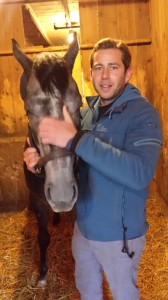
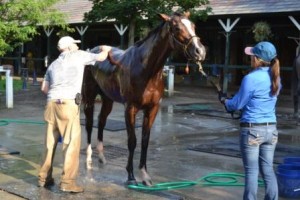
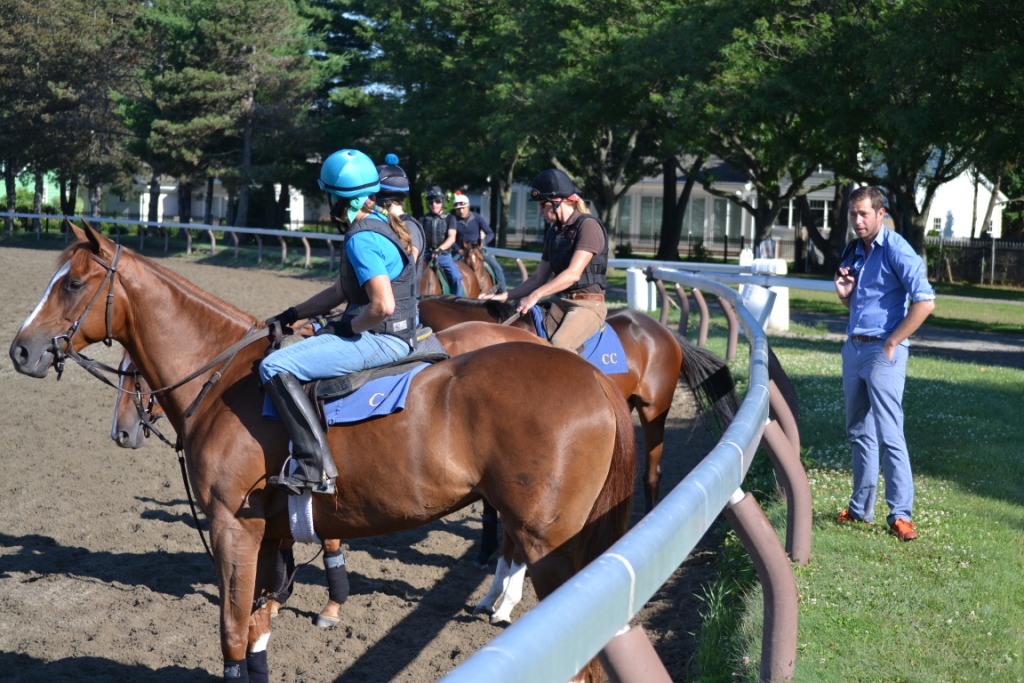
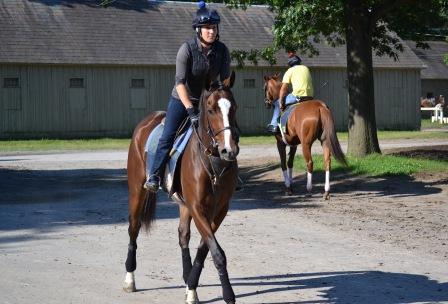
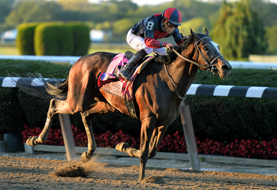
One comment on “Meet Thomas Brandebourger (Asst. Trainer to Christophe Clement)”